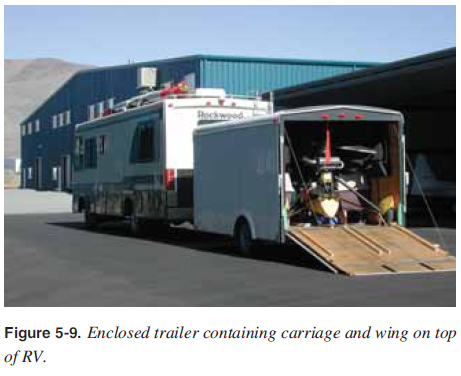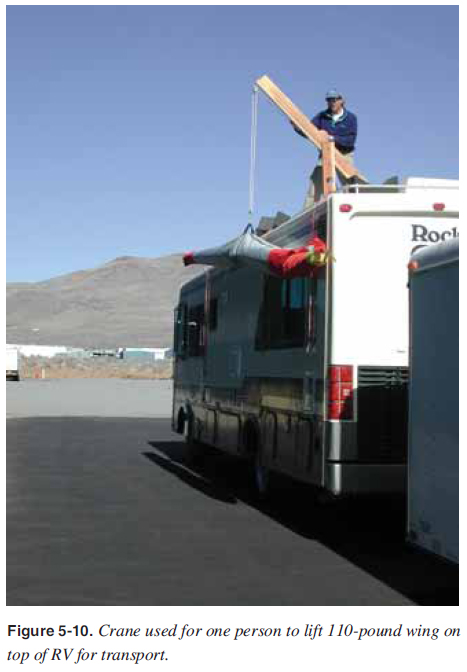
 |
|
||
| CHAPTER 5. Prefl ight and Ground Operations
Transporting It is best to keep the WSC aircraft in an enclosed hangar, but trailers may be used to transport, store, and retrieve the WSC carriage. If the trailer is large enough, the wing can also fi t inside the trailer. If not, then it must fi t on top of a trailer, truck, or recreational vehicle (RV). [Figure 5-9]  Enclosed trailers are preferred so the carriage is protected from the outside elements such as dust, rain, mud, road debris, and the interested person who may want to tinker with the carriage. The WSC carriage should fi t snuggly without being forced, be guarded against chafi ng, and well secured within any trailer. It is best to utilize hard points on the carriage frame and secure each wheel so the carriage cannot move fore and aft during transport. This is best accomplished by fi rst tying the front wheel from the axles, the fork, or a hard point on the frame with a slight forward pull. Then, secure the rear wheels from the axles or a hard point on the frame with a slight rearward pull. Guides on the side of the wheels and wheel chocks in front and back of each wheel are additionally helpful to secure the carriage on any trailer. The wing must have ample padding and should have at least three support points where it rests for transport. Transporting the wing properly is of critical importance because the wing resting on any hard surface can wear a hole in the sail and cause structural damage to the tubing. The greatest wear and tear on a wing can occur during transportation. Each support point should have equal pressureóno single point taking most of the load. The wing should be tied down at each attachment point to secure it, but not tight enough to damage the wing. Wide straps are better than thin ropes because the greater width creates less concentrated pressure on the wing at each tie-down point. Once the loading of the carriage and wing is complete [Figure 5-9], take a short drive, stop, and check for rubbing or chafi ng of components. Prior to taking the tow vehicle and trailer on the road, inspect the tires for proper infl ation and adequate tread. Ensure all lights are operable, the hitch is free moving and well lubricated, the tow vehicle attachment is rated for the weight of the trailer, and the vehicle and trailer brakes are operable. Avoid towing with too much or too little tongue weight, which causes the trailer to fi shtail at certain speeds, possibly rendering it uncontrollable. Be extremely cautious when unloading the wing and carriage. This is best done with two people since the wing usually weighs more than 100 pounds [Figure 5-10] and the carriage usually must roll down some incline to get from the trailer to the ground. Some carriages may be tail heavy without the wing, and caution must be exercised, especially moving up and down ramps. Check propeller clearance on the ground when transitioning onto or off of a ramp and propeller clearance going into and out of an enclosed trailer. If the carriage is transported in an open trailer, it should be covered and the propeller secured so it does not rotate/windmill during transport.  |
| ©AvStop Online Magazine Contact Us Return To Books |